How to Build a Social Media Content Calendar That Actually Works in 2025
Ever log into Instagram, TikTok or LinkedIn and freeze suddenly and think what to post today? You are not alone.
The truth is that in 2025 you cannot walk on social media. Algorithm shifts, short -form video dominance, and with the audience rolling faster than ever, randomness does not cut it. The winning brands are accompanied by structure, plan and consistency.
This is where a social media content calendar comes. In this guide we will cover:
- What a content calendar actually is (and why it’s more important than ever in 2025)
- Step-by-step instructions to build one from scratch
- Examples of calendar templates you can use (free & paid)
- Tools and workflows that make it easier
- Common mistakes to avoid
- A sample weekly and monthly calendar you can copy
By the end, you’ll have everything you need to stop scrambling and start building a social presence that actually grows your business.
What Is a Social Media Content Calendar & Why You Need One in 2025

Definition & Key Components
A social media content calendar is your master schedule of what you’ll post, where you’ll post, and when you’ll post it.
A excellent calendar commonly brings all of the shifting parts of your content collectively in one place. It outlines the exact posting dates and times, specifies which platfrom you’ll post on—whether or not that’s Instagram, TikTok, LinkedIn, or Facebook—and defines the content material type, consisting of a video, carousel, story, or blog link. It additionally continues your innovative belongings organized, which includes captions, hashtags, and visuals, while leaving room for notes, comments, or approvals if you’re running as a part of a team.
It’s basically your editorial backbone for social media.
What Changed Recently (2025 Updates & Trends)
Social media isn’t static, and 2025 has brought some new realities:
- Short-form video still dominates, but carousels and “saveable” content are resurging.
- AI-generated content is common, which means originality and planning are even more important.
- Platform fatigue is real—users are more selective, so consistent brand storytelling wins.
Key Benefits of Using a Calendar
- Keeps your posts aligned with campaigns and launches
- Saves you time and reduces last-minute panic
- Ensures you stay consistent across all platforms
- Gives you data for optimization (because you can track what worked)
- Improves team coordination if you want expert guidance, consider how a content marketing agency can help streamline planning and strategy
Step-by-Step: How to Create a Social Media Content Calendar
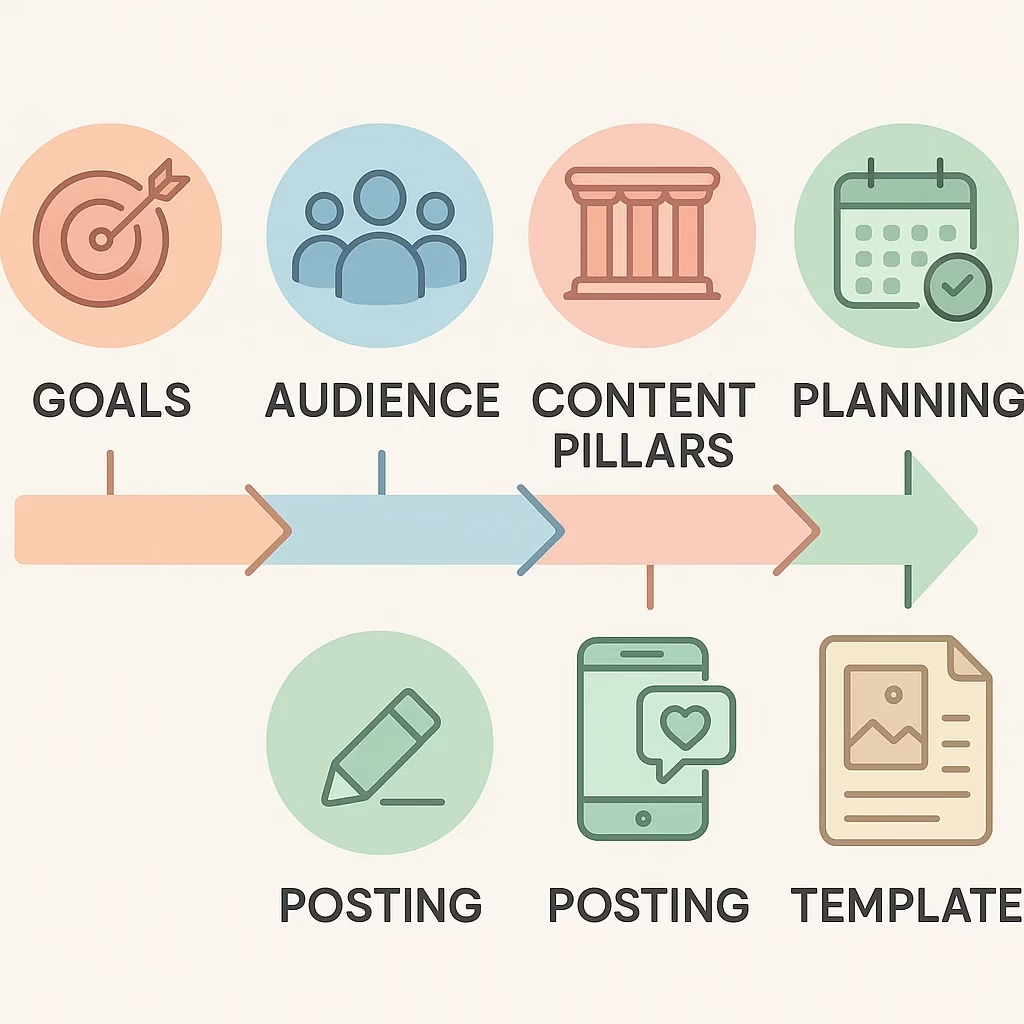
Define Your Goals
Ask yourself: What’s the main purpose of my content? Examples:
- Brand awareness
- Lead generation
- Direct sales
- Community building
Understand Your Audience & Platform Selection
Different platforms attract different audiences. TikTok may be perfect for short, viral clips, while LinkedIn might work best for thought leadership.
Choose Content Pillars & Topics
Content pillars are your recurring themes. Example for a fitness coach:
- Education (workout tips)
- Inspiration (client stories)
- Promotion (program launches)
- Lifestyle (behind-the-scenes)
Plan Monthly/Weekly Themes & Special Events
Tie your calendar to campaigns, launches, and holidays. A monthly social media content calendar makes sure you don’t miss key seasonal moments.
Decide Posting Frequencies & Formats
Don’t burn out. Start with:
- Instagram: 3–4x/week
- TikTok: 2–5x/week
- LinkedIn: 2–3x/week
- Stories: daily or near-daily
Select or Build a Template / Tool
If you’re starting small, try a Google Sheets social media content calendar template. Bigger teams might prefer tools like Trello, Notion, or Hootsuite.
Template Types & Free Resources
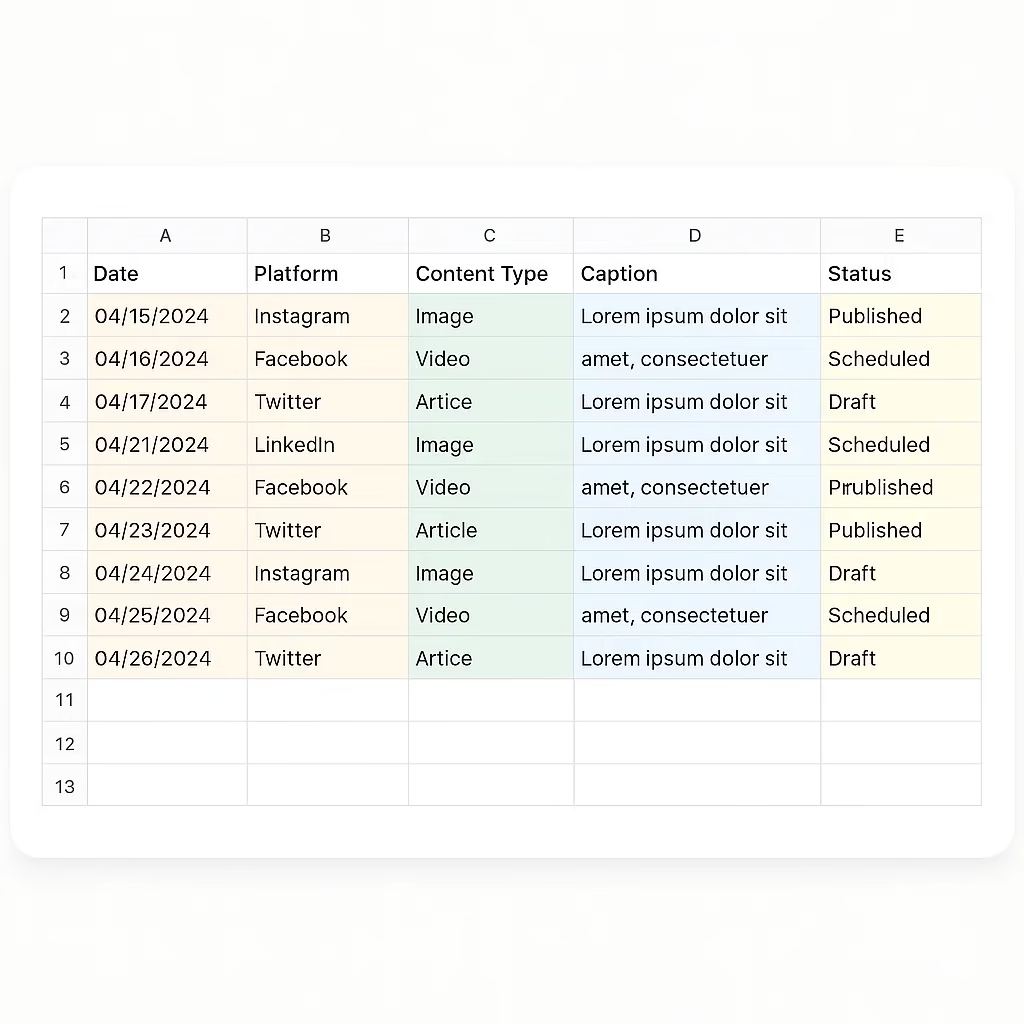
Excel & Google Sheets Templates
Simple and beginner-friendly. You can customize them to your style. Many people search for a social media content calendar excel template or Google Sheets social media content calendar template because they’re flexible and free.
Free Templates & Examples
👉 You can grab a free, ready-to-use sample social media content calendar template from HubSpot here. Just plug in your content ideas and you’re set.
Paid or Tool-Based Calendars & Software Options
If you need automation, look into:
- Hootsuite social media content calendar
- Buffer’s calendar view
- Metricool (analytics + scheduling)
Content Pillars & Idea Bank
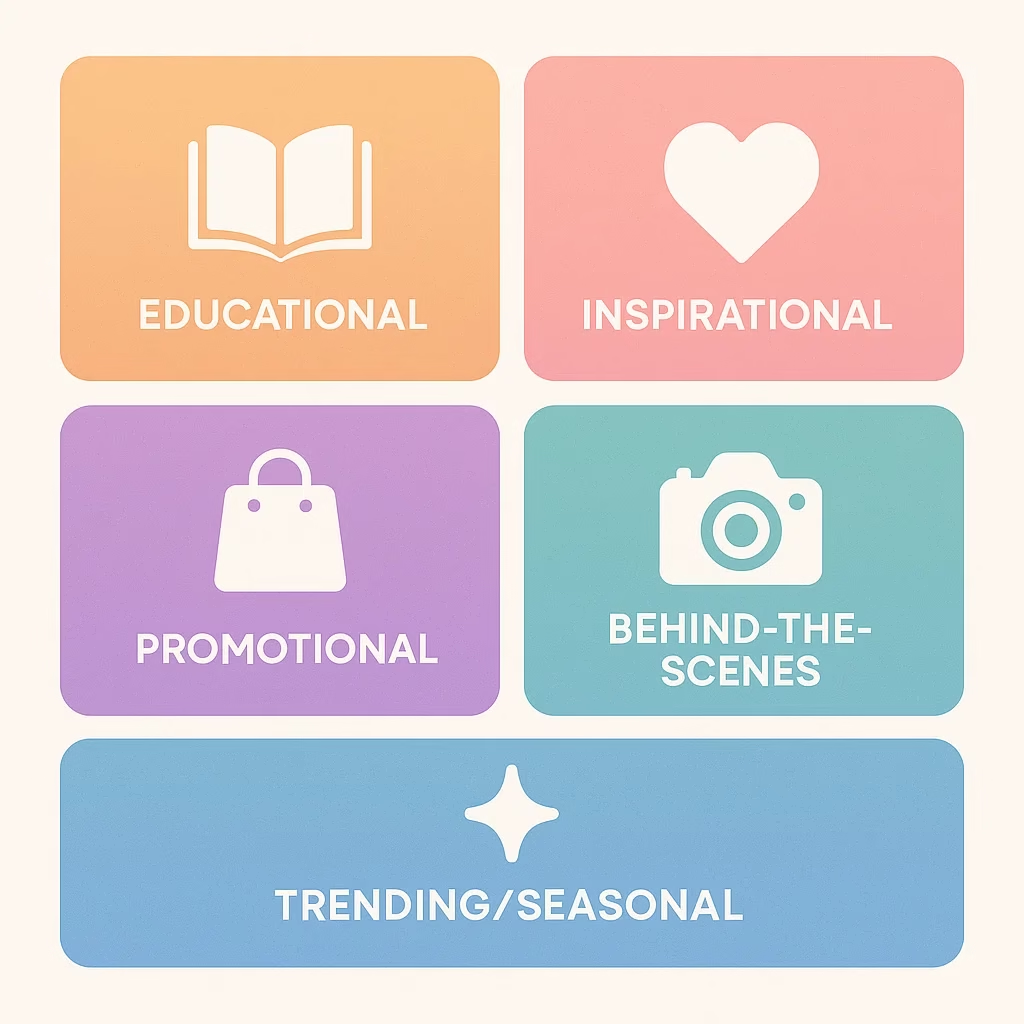
When you’re building a social media content calendar, one of the smartest moves you can make is to organize your ideas into clear content pillars. Think of them as your brand’s “buckets” of storytelling—each one making sure you balance value, engagement, and promotion. Here’s how to approach them:
Educational Content
Educational content is the backbone of most successful calendars. These are your tips, tutorials, and “how-to” posts—the type of content that positions your brand as an authority. For example, if you’re a fitness coach, you might share a carousel on “5 quick morning stretches” or a short video explaining proper form. If you’re in B2B, it could be a LinkedIn post breaking down an industry trend. Including educational posts in your monthly social media content calendar ensures you’re always delivering value, not just asking for attention.
Inspirational & Community-Driven Content
People don’t just connect with products—they connect with stories. Inspirational posts, such as client testimonials, success stories, or even motivational quotes, create that emotional bond. Community-driven content like user-generated posts also builds trust because it shows real people engaging with your brand. A restaurant, for example, could repost a customer’s dining photo, while a SaaS company might highlight a client’s success metrics. Adding this category to your social media calendar template strengthens authenticity and keeps your feed relatable.
Promotional / Sales Content
Of course, your calendar should also make space for posts that drive business results. Promotional content includes new product launches, seasonal offers, or highlighting a specific service. The key is balance: you don’t want every post to feel like an ad. Instead, plan these moments strategically in your weekly social media content calendar so that your promotions land effectively—without overwhelming your audience.
Behind-the-Scenes Content
Audiences love to peek behind the curtain. Behind-the-scenes content could be a quick TikTok showing your team at work, a “day in the life” vlog, or even a candid Instagram Story. These posts humanize your brand and make it easier for people to connect with you beyond just polished marketing content. In your social media content calendar spreadsheet, leave room for spontaneous BTS moments, because sometimes the casual posts perform just as well—if not better—than the polished campaigns.
Trending & Seasonal Content
Social media moves fast, and your calendar should have flexibility built in. Trending content might mean jumping on a viral TikTok sound or sharing your take on industry news. Seasonal content is also crucial—whether it’s Valentine’s Day, Black Friday, or an industry-specific awareness week. Planning these moments ahead in your social media marketing calendar means you won’t miss out on opportunities to be part of bigger conversations while still keeping your brand’s voice consisten
Scheduling & Consistency: Your Workflow
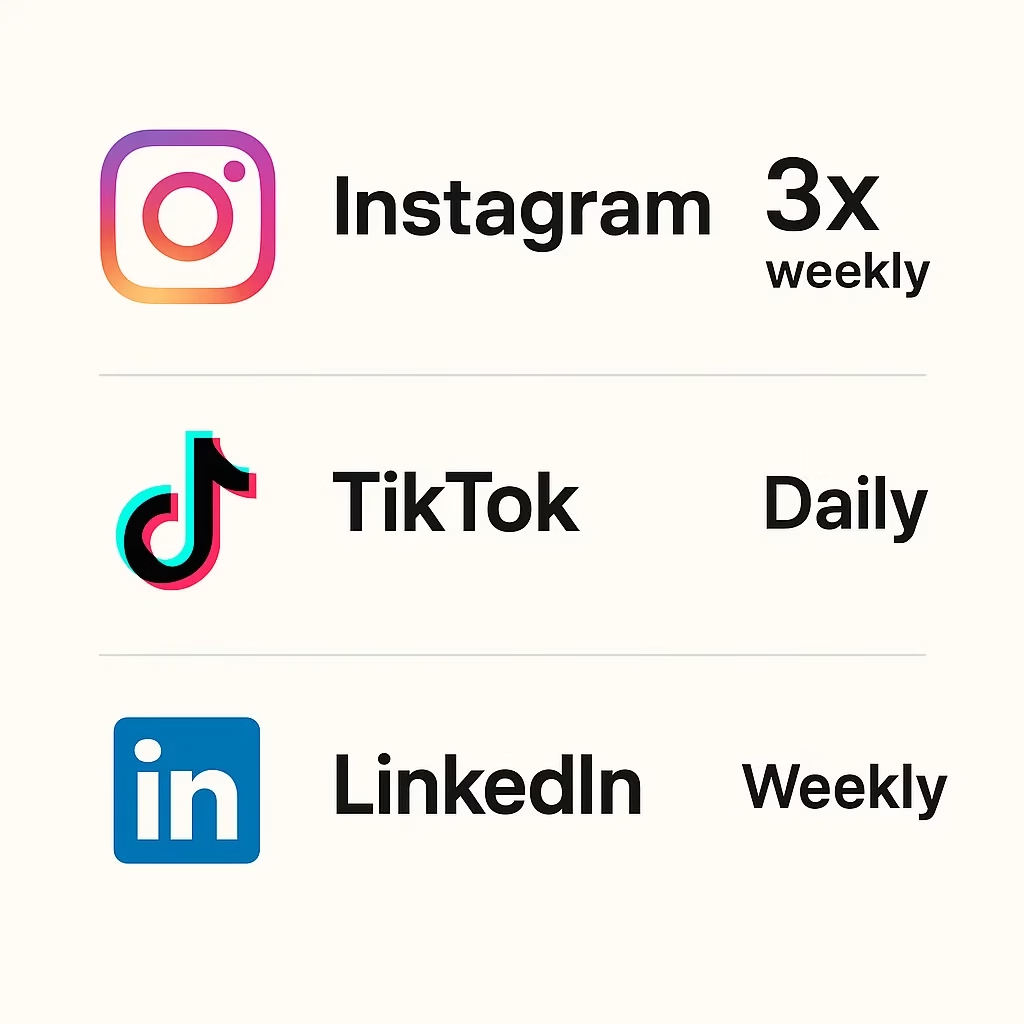
How Often to Post Per Platform
The golden rule for posting is to stay consistent without burning out. Every platform has its own rhythm. Instagram often works best with a few posts per week, TikTok rewards daily or near-daily uploads, while LinkedIn can thrive on one strong post a week. Instead of chasing unrealistic numbers, focus on what your team can maintain long term. A well-paced social media content calendar will always outperform random posting.
Planning Cadence
When it comes to planning, think of your calendar in two layers. A monthly outline helps you schedule major campaigns, product launches, or seasonal content well in advance. Weekly check-ins then allow you to refine details such as captions, hashtags, or platform-specific adjustments. This approach gives your social media calendar template structure while leaving room for creativity and timely ideas.
Tools & Processes
A strong calendar is more than just a posting schedule. It also helps you balance different types of content. Organize ideas into content buckets so your feed stays varied and engaging. A reliable formula many marketers use is 70 percent value-driven posts, 20 percent community-focused updates, and 10 percent promotional content. Following this balance keeps your monthly social media content calendar fresh and aligned with your long-term goals.
Tools & Software You Can Use
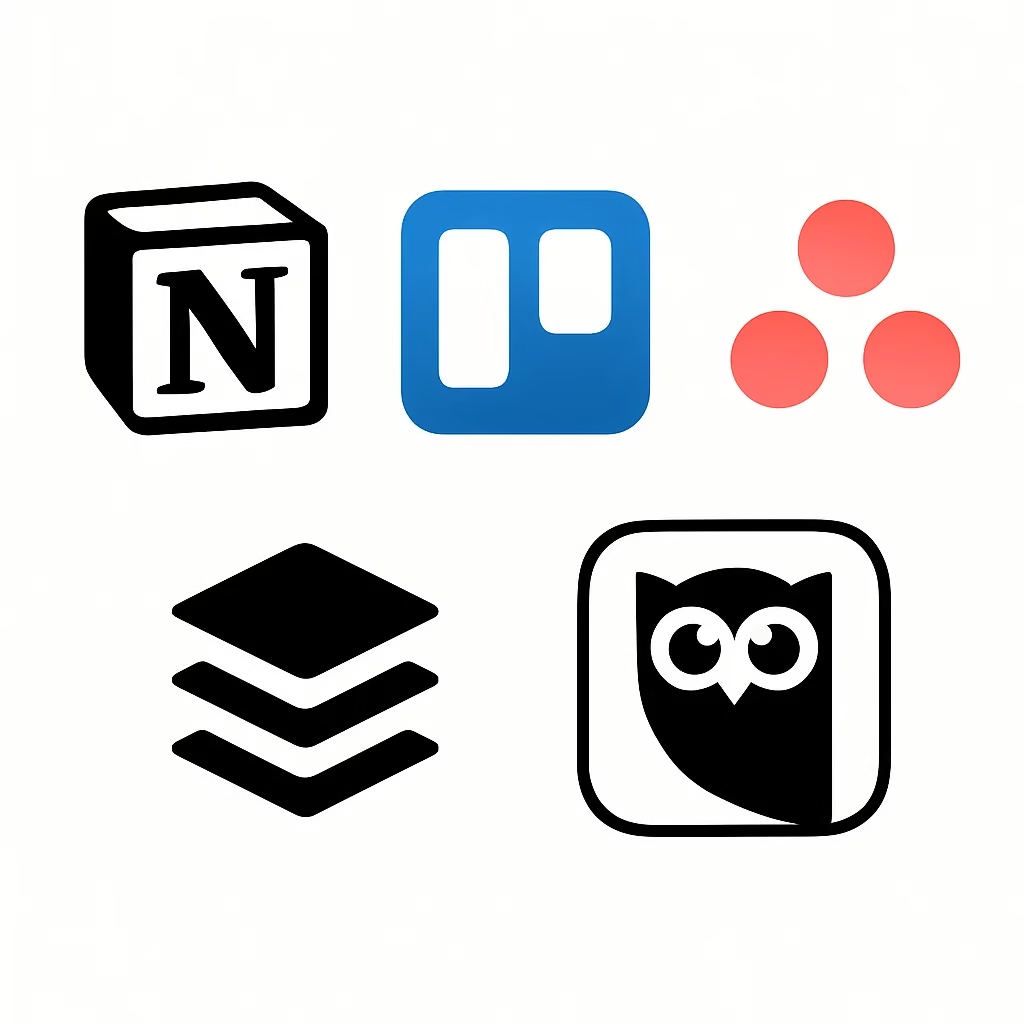
Spreadsheets (Google Sheets, Excel)
- ✅ Pros: Free, fully customizable, easy to organize by date, platform, content type, and captions
- ❌ Cons: Manual updates, no automation
Spreadsheets are perfect for solo creators or small teams who want full control over their social media content calendar. For additional efficiency, you can explore AI tools that help plan and manage content to save time and automate parts of your workflow.
Project Management Tools (Notion, Trello, Asana)
Great for team collaboration and brainstorming. These tools allow multiple contributors to plan, comment, and track progress in real time, keeping campaigns and approvals organized.
Social Media Management Software (Buffer, Hootsuite, Later, Metricool)
These platforms combine scheduling, analytics, and calendar visualization in one place. They help automate posting, monitor engagement, and provide insights on content performance.
Measuring What Matters: Analytics & Optimization
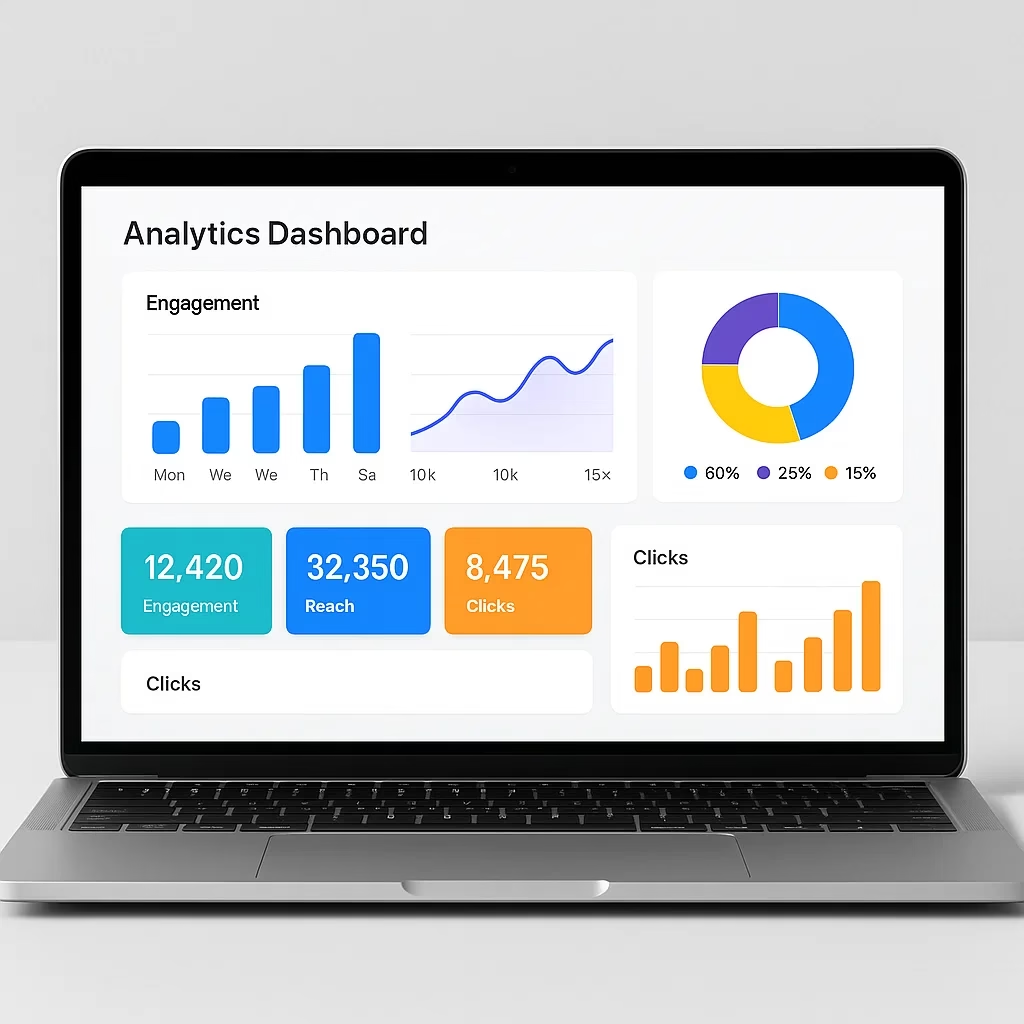
Key Metrics by Goal
- Awareness: reach, impressions
- Engagement: likes, comments, saves, shares
- Conversion: clicks, leads, sales
Spotting Content Gaps
Look at what’s underperforming → adjust.
Iterating & Pivoting
Do monthly reviews. Double down on what works, cut what doesn’t.
Common Mistakes & How to Avoid Them
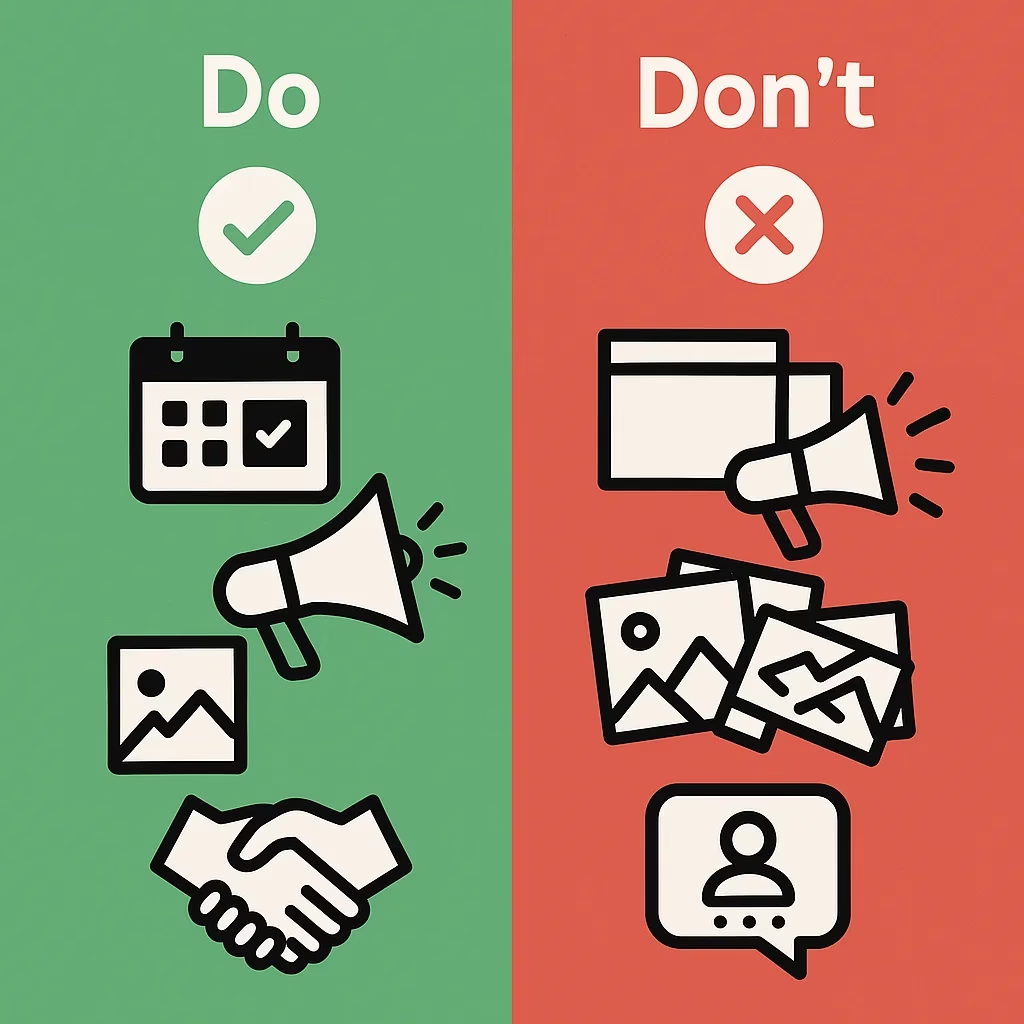
- Overloading with promos → nobody likes constant sales posts
- Being too rigid → leave space for trends
- Focusing only on vanity metrics → track what ties to business goals
- Spreading too thin → better to master 2 platforms than be mediocre on 6
Sample Weekly & Monthly Calendar + Example
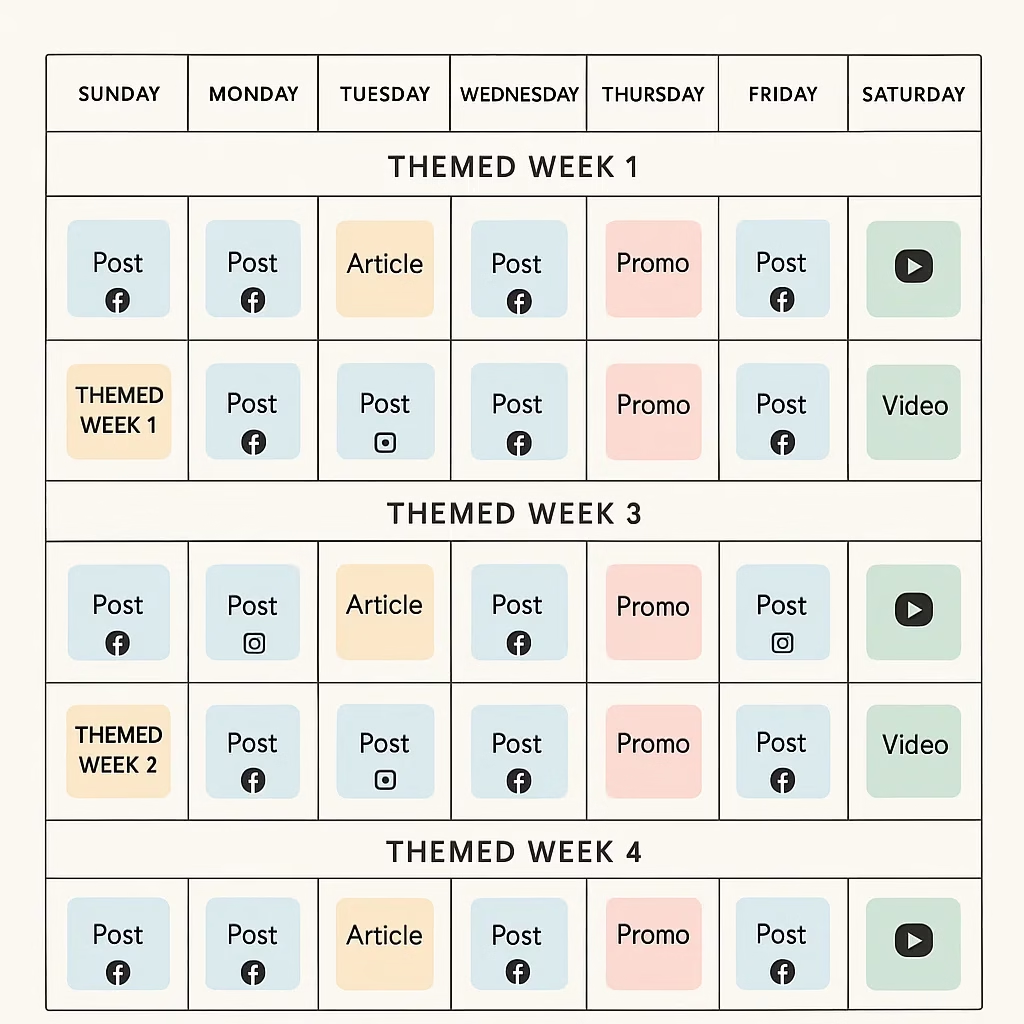
Let’s take a restaurant as an example.
Weekly Calendar Sample:
- Monday → Special dish spotlight
- Wednesday → Behind-the-scenes kitchen video
- Friday → Customer testimonial post
- Saturday → Trend-based reel (fun, shareable content)
Monthly Calendar Sample:
- Week 1: New menu launch posts
- Week 2: UGC campaign (customers sharing meals)
- Week 3: Staff highlights
- Week 4: Seasonal promo (Valentine’s dinner deal)
(Here you can show AI-generated visuals of the calendar mockups for extra clarity.)
Keyword Guide & Template Offers
If you’re wondering how to make a social media content calendar in Google Sheets or searching for a free sample social media content calendar template, the resources above will save you time.
👉 Download a Google Sheets social media calendar template to start planning today.
Conclusion
At the end of the day, a social media content calendar isn’t about perfection—it’s about consistency.
Start small. Plan one week ahead. Then build up to a month. With the right workflow, tools, and templates, you’ll not only save time but also build a stronger, more strategic presence online.
Remember: done is better than perfect.
Now it’s your turn—open a template, pick your first content pillars, and map out your next month. Future you (and your engagement rates) will thank you.
People Frequently Ask
What is a social media content calendar?
A social media content calendar is a tool that organizes your posts by date, platform, and content type. It helps maintain consistency, plan campaigns, track seasonal events, and ensure your brand voice stays clear across all channels.
How to create a content calendar for social media?
Start by defining your goals and understanding your audience. Choose platforms, set content pillars, plan monthly or weekly themes, and map out posting schedules. Use a template or tool to organize posts and track performance.
What is the best social media content calendar planner?
The best planner depends on your needs. Solo creators often prefer Google Sheets or Excel templates, while teams benefit from Notion, Buffer, Hootsuite, or Metricool for scheduling, collaboration, and analytics.
How to create a content calendar using ChatGPT?
Define your goals and content pillars, then use ChatGPT to generate post ideas, captions, and themes. Add these to a Google Sheets, Excel, or Notion calendar, adjust timing, and schedule posts to maintain consistency.







